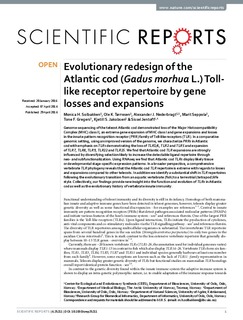| dc.contributor.author | Solbakken, Monica Hongrø | |
| dc.contributor.author | Tørresen, Ole Kristian | |
| dc.contributor.author | Nederbragt, Alexander Johan | |
| dc.contributor.author | Seppola, Marit | |
| dc.contributor.author | Gregers, Tone Fredsvik | |
| dc.contributor.author | Jakobsen, Kjetill Sigurd | |
| dc.contributor.author | Jentoft, Sissel | |
| dc.date.accessioned | 2017-03-30T13:24:56Z | |
| dc.date.available | 2017-03-30T13:24:56Z | |
| dc.date.created | 2016-05-02T10:02:51Z | |
| dc.date.issued | 2016 | |
| dc.identifier.issn | 2045-2322 | |
| dc.identifier.uri | http://hdl.handle.net/11250/2436386 | |
| dc.description.abstract | Genome sequencing of the teleost Atlantic cod demonstrated loss of the Major Histocompatibility Complex (MHC) class II, an extreme gene expansion of MHC class I and gene expansions and losses in the innate pattern recognition receptor (PRR) family of Toll-like receptors (TLR). In a comparative genomic setting, using an improved version of the genome, we characterize PRRs in Atlantic cod with emphasis on TLRs demonstrating the loss of TLR1/6, TLR2 and TLR5 and expansion of TLR7, TLR8, TLR9, TLR22 and TLR25. We find that Atlantic cod TLR expansions are strongly influenced by diversifying selection likely to increase the detectable ligand repertoire through neo- and subfunctionalization. Using RNAseq we find that Atlantic cod TLRs display likely tissue or developmental stage-specific expression patterns. In a broader perspective, a comprehensive vertebrate TLR phylogeny reveals that the Atlantic cod TLR repertoire is extreme with regards to losses and expansions compared to other teleosts. In addition we identify a substantial shift in TLR repertoires following the evolutionary transition from an aquatic vertebrate (fish) to a terrestrial (tetrapod) life style. Collectively, our findings provide new insight into the function and evolution of TLRs in Atlantic cod as well as the evolutionary history of vertebrate innate immunity. | |
| dc.language.iso | eng | |
| dc.title | Evolutionary redesign of the Atlantic cod (Gadus morhua L.) Toll-like receptor repertoire by gene losses and expansions | |
| dc.type | Peer reviewed | |
| dc.type | Journal article | |
| dc.source.volume | 6 | |
| dc.source.journal | Scientific Reports | |
| dc.identifier.doi | 10.1038/srep25211 | |
| dc.identifier.cristin | 1353484 | |
| dc.relation.project | Norges forskningsråd: 179569 | |
| dc.relation.project | Norges forskningsråd: 222378 | |
| dc.relation.project | Norges forskningsråd: 199806 | |
| cristin.unitcode | 201,15,2,0 | |
| cristin.unitname | Institutt for naturvitenskapelige fag | |
| cristin.ispublished | true | |
| cristin.fulltext | original | |
| cristin.qualitycode | 1 | |
